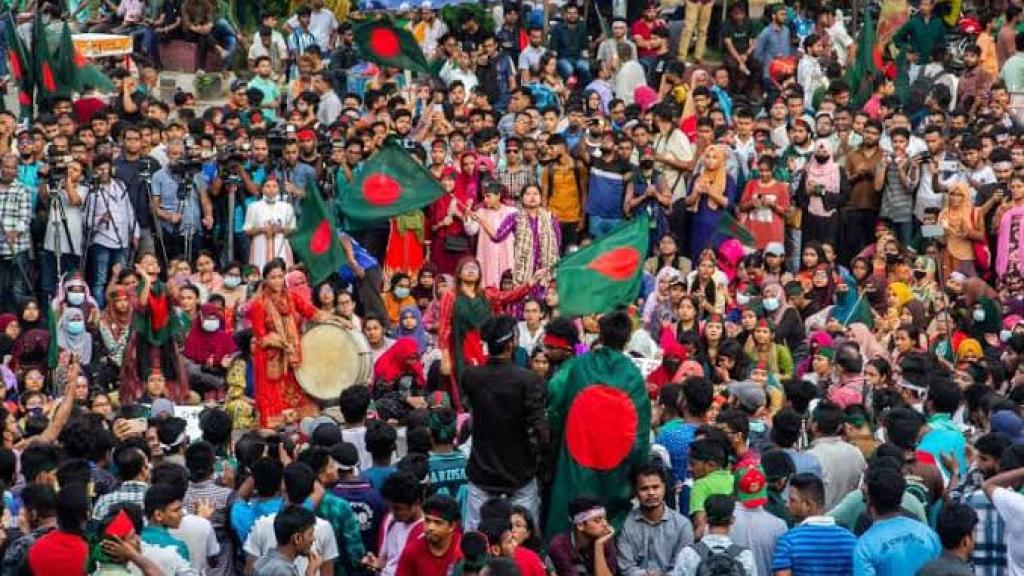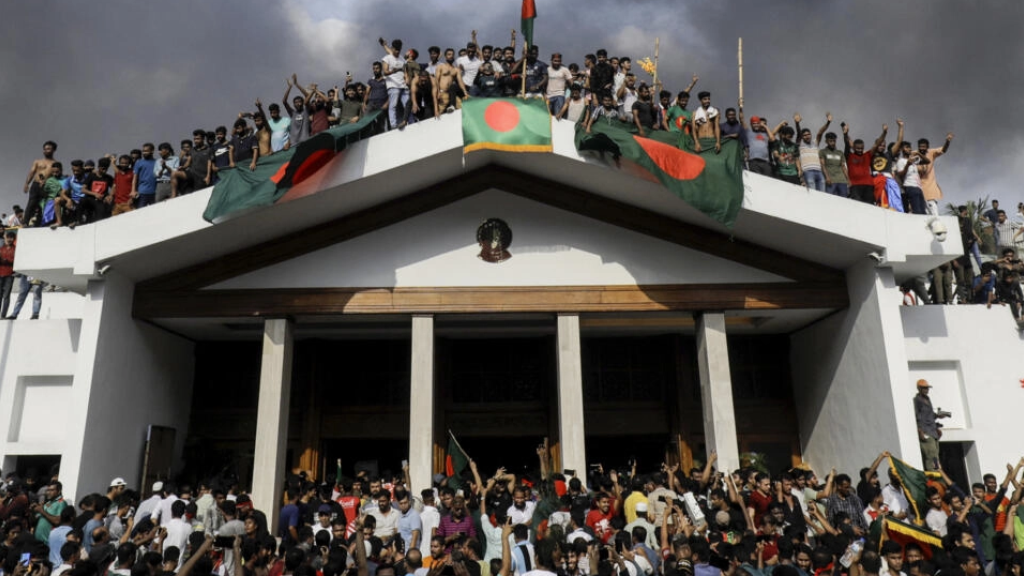Communist Party of India (Marxist-Leninist) Liberation: Statement on the developments in Bangladesh

First published at CPI(ML) Liberation.
With the Hasina government's attempt to crush the popular quota reform movement in Bangladesh by unleashing all-out violence, the student movement had grown into a people's upsurge for Sheikh Hasina's resignation and an end to her autocratic regime. Her resignation and exit from the country vindicates the anti-autocratic anger and assertion of the people of Bangladesh. We congratulate the democracy-loving people of Bangladesh at this hour of victorious assertion.
Bangladesh is currently in a turbulent phase of transition. There are disturbing reports of attacks on Awami League leaders and offices and on statues of Sheikh Mujibur Rahman and incidents of loot and arson, but there are also reassuring reports of movement forces being alive to the challenges of the situation and taking steps to defend the minorities and lives and properties of common citizens. Reports coming from Bangladesh indicate the possibility of an interim arrangement and the name of the veteran economist and Nobel Laureate Mohammad Yunus as the chief advisor to the new arrangement.
Democratic forces in India share the hope that Bangladesh will advance towards the goals of its Liberation War avoiding any protracted period of instability and anarchy and steering clear of the pitfalls of military rule, fundamentalist takeover and imperialist intervention that have often been seen to hijack the assertion and aspirations of a people fighting for change and democracy. Indian government must accept the sovereign choice of the people of Bangladesh in the spirit of friendship and cooperation.
A lot of misleading propaganda is being spread in the Indian media and social media on Bangladesh developments, with the aim of vitiating the social and political environment in India. We have to be on our guard to combat this propaganda war.

First published at CPI(ML) Liberation.
With the Hasina government's attempt to crush the popular quota reform movement in Bangladesh by unleashing all-out violence, the student movement had grown into a people's upsurge for Sheikh Hasina's resignation and an end to her autocratic regime. Her resignation and exit from the country vindicates the anti-autocratic anger and assertion of the people of Bangladesh. We congratulate the democracy-loving people of Bangladesh at this hour of victorious assertion.
Bangladesh is currently in a turbulent phase of transition. There are disturbing reports of attacks on Awami League leaders and offices and on statues of Sheikh Mujibur Rahman and incidents of loot and arson, but there are also reassuring reports of movement forces being alive to the challenges of the situation and taking steps to defend the minorities and lives and properties of common citizens. Reports coming from Bangladesh indicate the possibility of an interim arrangement and the name of the veteran economist and Nobel Laureate Mohammad Yunus as the chief advisor to the new arrangement.
Democratic forces in India share the hope that Bangladesh will advance towards the goals of its Liberation War avoiding any protracted period of instability and anarchy and steering clear of the pitfalls of military rule, fundamentalist takeover and imperialist intervention that have often been seen to hijack the assertion and aspirations of a people fighting for change and democracy. Indian government must accept the sovereign choice of the people of Bangladesh in the spirit of friendship and cooperation.
A lot of misleading propaganda is being spread in the Indian media and social media on Bangladesh developments, with the aim of vitiating the social and political environment in India. We have to be on our guard to combat this propaganda war.
After Hasina’s resignation, the struggle over the power vacuum continues in Bangladesh

First published at Europe Solidaire Sans Frontières.
On August 5, at 2:30 pm, Sheikh Hasina resigned from her post as prime minister and fled with some of her Special Security Forces by helicopter to India. She is now in Delhi, and some reports indicate that she wants to go to London for political asylum, but Britain is refusing her entry because of her human rights violations.
Later on the same day, at 4 pm, the Bangladesh Army’s Chief of Army Staff, General Waker-uz-Zaman, declared on national television that the army would take responsibility for maintaining law and order. He added that an interim government would be formed to run the country’s day-to-day affairs, and promised to hold a fair and free election soon. Army leaders met with the president, Mohammed Shahabuddin, that evening and discussed the formation of the interim government. Shahabuddin also called the leaders of different political parties in the parliament, including the main opposition party—the Bangladesh Nationalist Party (BNP). They all agreed to form an interim government.
However, the coordinators of the Anti-Discrimination Student Movement instead proposed forming an interim government with those who have led the mass movement. They said that they would not accept any other form of government without their consent, especially an army-led one. They underscored their paramount goal, which is removing all discrimination from society. The student coordinators reckoned that there is still a lot of work to do though Hasina has now fallen, and expressed their interest in being part of the interim national government as well. They urged all students and other people to defend the revolution, and be alert to ensure that no other reactionary forces could take advantage of the uprising.
Moreover, they proposed Dr. Muhammad Yunus as the chief of the advisory committee for the interim government. Though Hasina’s regime has long targeted Yunus, his policies are not without controversy. He is well-known for endorsing microcredit for solving social ills, and has a higher standing in the NGO sphere than among marginalized communities. Some leftist organizations and parties have already criticized him as the trump card of US imperialism.
So, despite Hasina’s resignation, the struggle over the power vacuum continues in Bangladesh.
Nevertheless, the movement that started on July 15 amidst the killing of six students at Dhaka University and after the death of Abu Sayed, a 4th-year honors English student at Begum Rokeya University who was shot to death in broad daylight by police in Rangpur, reached an important culmination on August 5.
On her last day, the dictator still had her last bite, with her security forces claiming at least 39 more lives. Ultimately, the dictatorship could not sustain itself amidst the pressure of millions of students and people. In Hasina’s final moments as prime minister, security authorities defied her dictates and refused to shoot any more civilians. They gave her two options: either to cling to power or give up and escape. She chose to flee the country. Hasina used all the tools of repression at her disposal against the people to retain power, but was defeated in the end.
The students’ movement began with the demand for reforming a discriminatory quota system. The increasingly repressive measures taken by Hasina compelled them to expand their demands, including the call for the resignation of multiple Awami League officials and compensation for families of those who were killed or injured in the protests. The students engaged in a diversity of actions, including civil disobedience. Hasina branded the protestors as ’razakar’ (traitors during the independence struggle in 1971 who collaborated with Pakistani war criminals), leading the students to escalate their demands and strategy. They developed nine demands as Hasina resorted to further repression. Later, they focused on one key demand—demanding Hasina’s resignation — which they successfully won.
The autocrat had also announced an all-out curfew across the country on July 18 in order to suppress the student movement. However, the students and masses ignored the curfew and continued to take the streets. Later, the regime escalated even further and declared that soldiers would shoot protestors on sight. However, all the measures they took were boldly broken by the masses of students. They stood on their feet before the bullets of the army and police by offering their lives without hesitation.
Since July 15, more than 339 students have been killed by the police, according to a major daily news outlet. But, according to a private survey, the death toll may be even higher—numbering over thousands. Thousands of students have been injured and tortured: some have lost their eyesight, and others have body parts mutilated.
Ultimately, Hasina’s latest reign lasted around 16 years. Her regime marked widespread human rights violations, corruption, plundering of the state’s wealth, forced disappearance of activists, extra-judicial killings, holding fake elections, etc. She should be tried by international tribunes for her human rights violations and complicity in genocide.
No comments:
Post a Comment